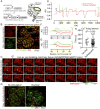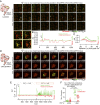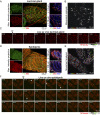Multiscale imaging of basal cell dynamics in the functionally mature mammary gland
- PMID: 33033227
- PMCID: PMC7604439
- DOI: 10.1073/pnas.2016905117
Multiscale imaging of basal cell dynamics in the functionally mature mammary gland
Abstract
The mammary epithelium is indispensable for the continued survival of more than 5,000 mammalian species. For some, the volume of milk ejected in a single day exceeds their entire blood volume. Here, we unveil the spatiotemporal properties of physiological signals that orchestrate the ejection of milk from alveolar units and its passage along the mammary ductal network. Using quantitative, multidimensional imaging of mammary cell ensembles from GCaMP6 transgenic mice, we reveal how stimulus evoked Ca2+ oscillations couple to contractions in basal epithelial cells. Moreover, we show that Ca2+-dependent contractions generate the requisite force to physically deform the innermost layer of luminal cells, compelling them to discharge the fluid that they produced and housed. Through the collective action of thousands of these biological positive-displacement pumps, each linked to a contractile ductal network, milk begins its passage toward the dependent neonate, seconds after the command.
Keywords: GCaMP6; calcium signaling; lactation; mammary gland; oxytocin.
Conflict of interest statement
The authors declare no competing interest.
Figures






Similar articles
-
Essential role of Orai1 store-operated calcium channels in lactation.Proc Natl Acad Sci U S A. 2015 May 5;112(18):5827-32. doi: 10.1073/pnas.1502264112. Epub 2015 Apr 20. Proc Natl Acad Sci U S A. 2015. PMID: 25902527 Free PMC article.
-
Methods for Imaging Intracellular Calcium Signals in the Mouse Mammary Epithelium in Two and Three Dimensions.Methods Mol Biol. 2025;2861:195-212. doi: 10.1007/978-1-0716-4164-4_15. Methods Mol Biol. 2025. PMID: 39395107
-
Asymmetric expression of connexins between luminal epithelial- and myoepithelial- cells is essential for contractile function of the mammary gland.Dev Biol. 2015 Mar 1;399(1):15-26. doi: 10.1016/j.ydbio.2014.11.026. Epub 2014 Dec 11. Dev Biol. 2015. PMID: 25500615 Free PMC article.
-
The extracellular matrix as an adhesion checkpoint for mammary epithelial function.Int J Biochem Cell Biol. 2007;39(4):715-26. doi: 10.1016/j.biocel.2006.11.004. Epub 2006 Nov 23. Int J Biochem Cell Biol. 2007. PMID: 17251051 Free PMC article. Review.
-
Neuroendocrine control of the milk ejection reflex.J Dairy Sci. 1983 Oct;66(10):2226-35. doi: 10.3168/jds.S0022-0302(83)82072-4. J Dairy Sci. 1983. PMID: 6358292 Review.
Cited by
-
Developing ovine mammary terminal duct lobular units have a dynamic mucosal and stromal immune microenvironment.Commun Biol. 2021 Aug 20;4(1):993. doi: 10.1038/s42003-021-02502-6. Commun Biol. 2021. PMID: 34417554 Free PMC article.
-
Gene expression signatures of individual ductal carcinoma in situ lesions identify processes and biomarkers associated with progression towards invasive ductal carcinoma.Nat Commun. 2022 Jun 13;13(1):3399. doi: 10.1038/s41467-022-30573-4. Nat Commun. 2022. PMID: 35697697 Free PMC article.
-
Network representation of multicellular activity in pancreatic islets: Technical considerations for functional connectivity analysis.PLoS Comput Biol. 2024 May 13;20(5):e1012130. doi: 10.1371/journal.pcbi.1012130. eCollection 2024 May. PLoS Comput Biol. 2024. PMID: 38739680 Free PMC article.
-
Mammary gland physiology and farm management of dairy mares and jennies.JDS Commun. 2022 Jan 10;3(3):234-237. doi: 10.3168/jdsc.2021-0174. eCollection 2022 May. JDS Commun. 2022. PMID: 36338815 Free PMC article. Review.
-
The immune environment of the mammary gland fluctuates during post-lactational regression and correlates with tumour growth rate.Development. 2022 Apr 15;149(8):dev200162. doi: 10.1242/dev.200162. Epub 2022 Apr 29. Development. 2022. PMID: 35420674 Free PMC article.
References
-
- Lloyd-Lewis B., Harris O. B., Watson C. J., Davis F. M., Mammary stem cells: Premise, properties and perspectives. Trends Cell Biol. 27, 556–567 (2017). - PubMed
Publication types
MeSH terms
Substances
LinkOut - more resources
Full Text Sources
Other Literature Sources
Molecular Biology Databases
Miscellaneous

